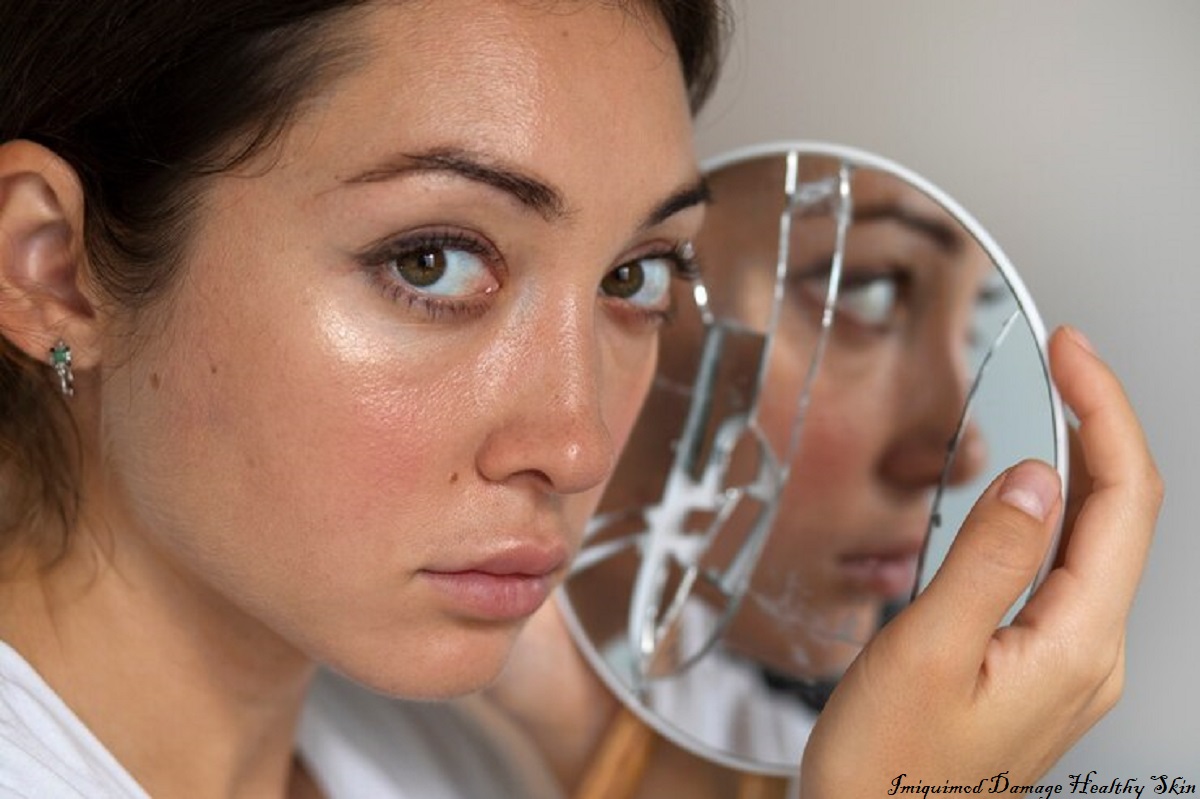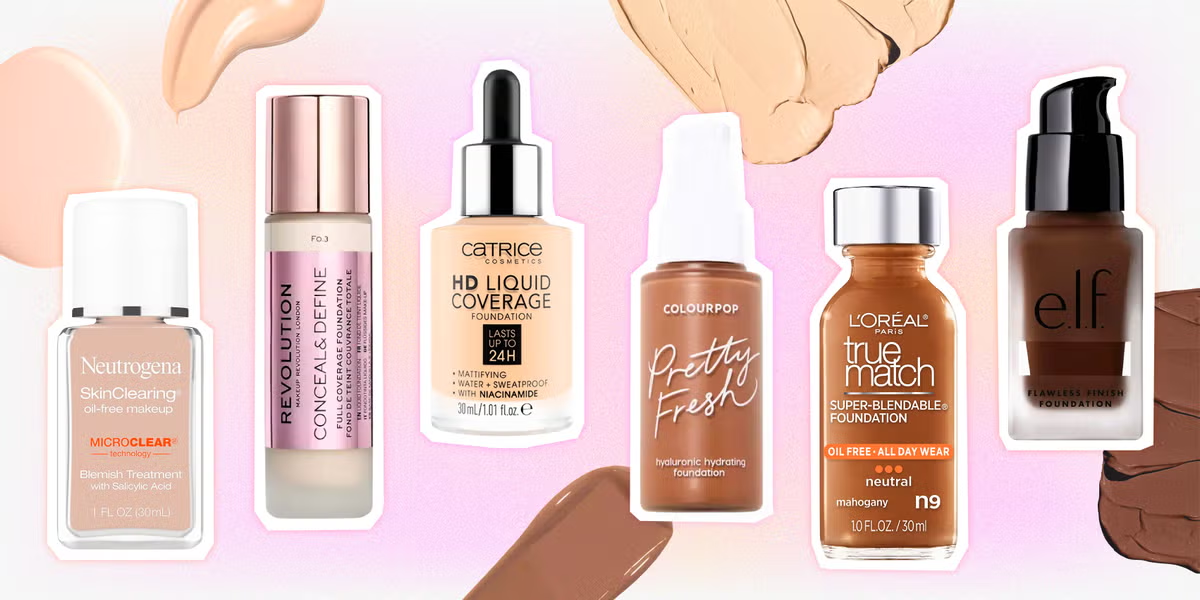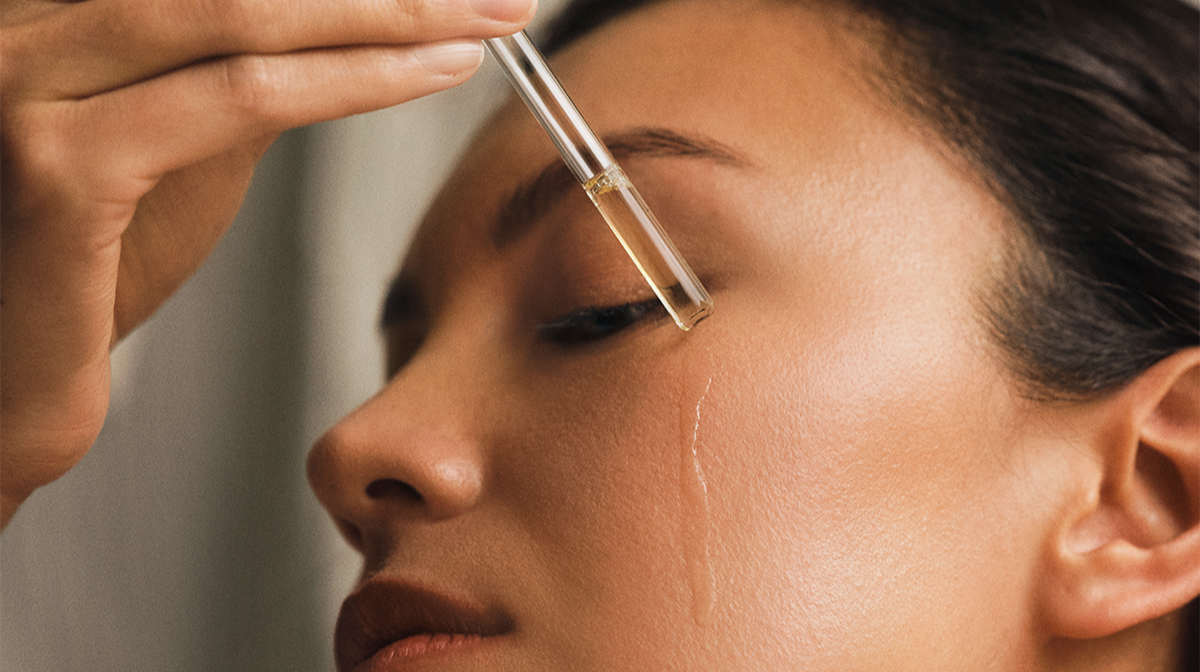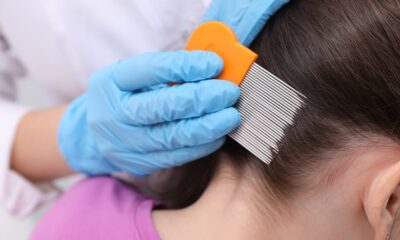Skin
Does Imiquimod Damage Healthy Skin?

Imiquimod Damage Healthy Skin: A topical drug called imiquimod is frequently prescribed to treat some skin disorders, including genital warts, superficial basal cell carcinoma, and actinic keratosis. To help the body identify and eliminate aberrant cells, it stimulates the immune system to release cytokines and other immune molecules. Despite its well-established efficacy, there are worries about how it may affect healthy skin, especially in the vicinity of the application site. In addition to discussing what users should know before beginning treatment, this article explores whether imiquimod can harm healthy skin.
How Imiquimod Works
Imiquimod falls under the category of immune response modifiers. Instead of killing aberrant cells directly, it triggers the immune system to do the job. When applied, it promotes the release of cytokines such as tumor necrosis factor-alpha and interferon-alpha. These chemicals encourage inflammation, which aids the immune system’s ability to recognize and eliminate aberrant or malignant cells. It is used to treat diseases like actinic keratosis and some types of skin cancer because of this.
Potential Side Effects of Imiquimod
Because imiquimod works by stimulating an immune response, it’s not uncommon for users to experience side effects in both the treated and surrounding areas. The most common side effects include:
Redness
Swelling
Erosion or ulceration
Scabbing and crusting
Pain or discomfort
Itching
Dryness
These symptoms usually occur within a few days of starting treatment and are an expected part of the immune response. In many cases, they indicate that the medication is working to remove abnormal cells. However, these side effects can sometimes extend to healthy skin, causing concern for users.

Potential Side Effects of Imiquimod
Does Imiquimod Affect Healthy Skin?
When using imiquimod, it’s crucial to understand that the inflammatory response it triggers is not confined to abnormal cells alone. The medication may also cause inflammation in nearby healthy skin, particularly if applied too broadly. This can lead to temporary redness, irritation, and other side effects in areas otherwise unaffected by the underlying condition.
The Impact on Healthy Skin
While imiquimod is not designed to damage healthy skin, it can cause several temporary side effects in surrounding areas. These include:
Inflammation:
Since imiquimod activates the immune system, nearby healthy skin can become inflamed. This often results in redness, swelling, or a burning sensation. While uncomfortable, this reaction is typically temporary and subsides after the treatment course ends.
Erythema (Redness):
Redness is one of the most common side effects. It often spreads beyond the application area to surrounding healthy skin. Though alarming, this redness usually fades after the course of treatment is completed.
Erosion and Ulceration:
In severe cases, imiquimod can cause healthy skin to erode or develop ulcers. This tends to occur when the medication is used over large areas or for extended periods. Most erosions heal without scarring, but they can be painful and concerning.
Itching and Burning:
These sensations can also occur in healthy skin surrounding the treated area. This is due to the immune system’s activation, which increases sensitivity and irritation in the skin.
Preventing Damage to Healthy Skin
Although some irritation to healthy skin is expected when using imiquimod, there are ways to minimize potential damage. Here are some tips for applying imiquimod safely:
Apply Precisely:
Always apply imiquimod exactly as prescribed by your healthcare provider. Use a cotton swab or your fingertip to apply the medication only to the affected area. Avoid spreading it onto surrounding healthy skin.
Use a Barrier:
Some patients find it helpful to use a protective barrier cream, such as petroleum jelly, around the treatment area. This helps protect nearby healthy skin from coming into contact with the medication.
Follow Dosing Instructions:
Use the medication only as often as prescribed. Applying more than the recommended amount won’t speed up the healing process and may increase the likelihood of irritation.
Avoid Sun Exposure:
Imiquimod-treated skin is more sensitive to sunlight. Avoid excessive sun exposure and wear protective clothing or sunscreen to prevent further irritation or damage.
Manage Symptoms:
If the surrounding skin becomes too irritated, consult your doctor. They may recommend adjusting your treatment schedule or using topical steroids or soothing creams to manage the symptoms.
When to Seek Medical Advice
While most side effects of imiquimod are manageable, there are situations where medical advice is necessary. Contact your healthcare provider if:
The skin irritation becomes severe or unbearable.
Large areas of healthy skin develop ulcers or erosions.
There is a significant amount of bleeding, pain, or infection at the treatment site.
The symptoms persist even after stopping the treatment.
In some cases, doctors may recommend stopping or pausing treatment if the irritation becomes too severe. They may also suggest alternative treatments if imiquimod proves too harsh for your skin.
Long-term Effects on Healthy Skin
The majority of imiquimod’s adverse effects, such as skin irritation, are transient and go away after treatment is finished. Usually, the skin recovers without sustaining any long-term harm. Rarely, though, there might be more long-lasting adverse effects like pigmentation changes or scarring, particularly if the skin becomes severely eroded or ulcerated.
It’s worth noting that these cases are uncommon, and the vast majority of patients see their skin return to normal within a few weeks of finishing treatment. Additionally, the benefits of treating skin conditions like actinic keratosis or superficial basal cell carcinoma often outweigh the temporary discomfort and risk of mild damage to healthy skin.
Conclusion
Imiquimod is a powerful medication that effectively treats certain skin conditions by activating the immune system. While it can cause temporary irritation and damage to the healthy skin surrounding the treatment area, these side effects are generally manageable and resolve after treatment ends. Most patients experience mild to moderate reactions, such as redness or swelling, which indicate the immune system’s activity. Severe reactions are rare but possible, especially if the medication is applied improperly or used for extended periods.
To minimize the risk of damaging healthy skin, it’s important to apply the medication precisely and follow your doctor’s instructions closely. If side effects become too severe, seeking medical advice is crucial to ensure that the treatment is adjusted or stopped as needed.
Ultimately, while imiquimod can irritate healthy skin, the potential benefits in treating skin conditions often outweigh these temporary side effects. With careful application and management, imiquimod can be a safe and effective option for many patients dealing with abnormal skin growth.
Skin
Best Drugstore Foundations for Oily Skin and Full Coverage

Finding the perfect foundation for oily skin, especially with full coverage, can feel like a tall order. Luckily, drugstores offer a treasure trove of affordable options that provide a flawless finish and extended wear without excess shine. For those with skin prone to oiliness, choosing a foundation that balances lightweight coverage with oil control is essential. Here’s a guide to help you discover the best pharmacy foundations for oily skin that also deliver comprehensive coverage.
Why Oily Skin Requires Specialized Foundation Care
Oily skin naturally produces more sebum, which can reduce the longevity of makeup and create unwanted shine throughout the day. Selecting an unsuitable foundation can exacerbate these issues, leading to a heavy sensation, undesirable gloss, and even clogged pores. Opting for a foundation tailored specifically to with full coverage capabilities, allows you to mask imperfections while maintaining a lasting matte finish.
Key Considerations for Selecting the Best Foundation for Oily Skin
- Matte Finish: Essential for reducing shine and managing excess oil production.
- Long-Wearing Formula: Ensures your look holds up throughout the day.
- Non-Comedogenic Composition: Helps prevent breakouts by keeping pores clear.
- Adjustable Coverage: Allows for a customizable finish without overburdening the skin.

Top 5 Drugstore Foundations for Oily Skin and Full Coverage
1. L’Oréal Infallible Pro-Matte Foundation
L’Oréal’s Infallible Pro-Matte Foundation is renowned for its matte effect and long-lasting wear. Its lightweight, breathable formula offers adjustable coverage that conceals flaws without clogging pores. With a smooth texture and easy application, it’s perfect for those seeking full coverage minus the heavy feeling.
Key Features:
- Long-lasting matte finish.
- Non-comedogenic formula.
- Maintains coverage even in hot or humid conditions.
2. Maybelline Fit Me Matte + Poreless
The Fit Me Matte + Poreless is a popular, budget-friendly option among individuals with oily skin. Its formula is crafted to minimize pore visibility and control shine throughout the day. This foundation adapts to various skin tones, offering buildable coverage that ranges from light to medium.
Key Features:
- Lightweight, non-greasy texture.
- Shine control for a natural matte look.
- Extensive shade range to suit all skin types.
3. Revlon ColorStay Foundation for Combination/Oily Skin
The Revlon ColorStay Foundation is a top choice for those seeking full coverage with an immaculate finish. Formulated for combination with oily skin types, it provides up to 24 hours of wear without compromising comfort. With added mattifying agents, it absorbs excess sebum, ensuring a smooth, shine-free complexion.
Key Features:
- Full coverage with a matte finish.
- Water and sweat-resistant.
- Long-wearing, transfer-resistant formula.
4. NYX Can’t Stop Won’t Stop Foundation
NYX’s Can’t Stop Won’t Stop Foundation offers high coverage with a lasting matte effect. Its lightweight, non-comedogenic formula is ideal for oily skin, helping to keep an even, shine-free tone. Available in an extensive shade range, it’s perfect for those looking for customizable coverage with effective oil control.
Key Features:
- Lightweight formula suited for oily skin.
- Wide variety of shades for a precise match.
- Designed to hold up all day without retouching.
5. Covergirl Clean Matte BB Cream for Oily Skin
While technically a BB cream, Covergirl’s Clean Matte provides excellent coverage in a light, comfortable formula. Its mattifying composition controls shine without blocking pores, making it a great option for a natural yet polished look. Ideal for days when you prefer lighter makeup while still covering blemishes.

Key Features:
- Oil-free formula to minimize shine.
- Suitable for sensitive, acne-prone skin.
- Buildable light to medium coverage.
Tips for Perfect Foundation Application on Oily Skin
- Prep Your Skin: Cleanse and moisturize with oil-free products before applying makeup. Proper skin care aids in prolonging foundation wear.
- Use a Mattifying Primer: Primers specifically for oily skin help control oil production and extend foundation longevity.
- Apply in Thin Layers: Avoid a cakey effect by applying foundation in thin layers. Add more only where needed for extra coverage.
- Set with a Translucent Powder: Use a mattifying powder to lock in the foundation and reduce shine. Translucent powders are ideal for achieving a natural finish without adding color.
- Finish with a Setting Spray: A setting spray can add extra hold, perfect for long days or special events.
Conclusion
Finding the right foundation for oily skin and full coverage doesn’t have to break the bank. Drugstores offer a range of high-quality options tailored to the unique needs of oily skin. By selecting the right product and following a few key application techniques, you can achieve a lasting, matte, and shine-free look throughout the day. Experiment with different options to find the perfect match for your skin type and coverage preferences.
Skin
2025 Skincare Trends We’re Loving

2025 will see many exciting Skincare Trends that are not only effective but also durable and gentle on the gel. Every year new developments are seen in the world of skin care as a result of new technologies and our understanding of our skin. From personal skin care routines to eco-friendly products, these giants help us in our pursuit of healthy, glowing skin.
Personal care reflected by AI
Personalizing skin care will take center stage in 2025, with AI-powered analytics to individually assess the skin and tailor ideal products and routines to the type of burn, and imperfections that the skin faces daily. Scans conditions, and provides recommendations for sun exposure, humidity, and more.
Benefits of AI-Based Skin Care
. Product suggestions
. Reducing unnecessary products
. Routines are subject to individual needs
Minimal skin care routines
This method will also apply in 2025. The trend towards a minimal skin care routine is favored by many people as it saves time and puts less stress on the skin. Instead, many people rely on three to four steps that include hydration, cleansing, and protection.
Minimal maintenance benefits
. Reduces skin irritation thanks to less product
. Time and cost savings
. Focus on quality rather than quantity
Skincare with natural ingredients
Consumers are increasingly appreciating products without artificial additives and synthetic fragrances because they often irritate the skin less. Natural skin care is increasingly becoming a necessity. Because they are light and efficient.
Popular Natural Ingredients 2025
. Plant oleic acidSugar cane squalene
. Vitamin C from fruits
How Blue Light Protection Protects Skin
. New light absorption by antioxidants
. Reduction of cell damage
. Prevention of premature aging
The skin barrier protects us from external influences and prevents moisture loss Sara Minds New Ingredients like Cenamid and fatty acids help strengthen the barrier and make the skin more elastic A strong skin barrier is healthy skin Key is and in 2025 the focus will be on products that support and strengthen the mesh barrier.
Important ingredients for strengthening the skin barrier
. Saccharomyces for natural contraception
. Omega fatty acids for flexibility
. Panthenol to soothe the skin
Biotechnology Inventions
Mimicking natural processes to create products that can specifically address specific skin concerns Biotechnology is revolutionizing the skin care industry In 2025 we will see a variety of bioengineered ingredients. Which are very pure and effective.
Advantages of Biotechnology Ingredients

. High potency and purity
. Better skin tolerance
. Environmentally friendly production
Microbiome Friendly Products
Microbiome-friendly products contain prebiotics and probiotics that help balance the skin and fight inflammation. There will be a burden
Why microbiome care is important
. Soothes and balances inflammation
. Supports tissue immunity
. Protects against harmful bacteria
Skincare for men
From aftershave balms to face masks, men’s skincare is evolving and requires more care than ever. Men’s grooming will be more diverse in 2025. Men are increasingly valuing these products. are tailored to their specific needs
Generic Men’s Skin Care Products
. Cleansing marks for oily traps
. Eye creams to reduce signs of fatigue
. Facial moisturizing creams
Skin Care Routines for Every Stage of Life
Skincare routines are becoming more targeted and age-themed, with anti-aging products for the 40s, hydrating products for the 20s, and skin-soothing ingredients for the teens. have their own specific needs and in 2025 more and more products will cater to these differences.
Focus on skin care and grooming
2025 It’s not just about external care, it’s also about internal well-being. Many people incorporate mindfulness practices such as massage, meditation or calming scents into their skin care routines. Zen is a growing trend. is now making its way into skin care.
Benefits of mental skin care

. Creating a moment of pampering in everyday life
. Reducing stress through relaxation rituals
. Improving skin condition through internal aura
Weather-friendly sustainable skincare
Conscious manufacturing processes are accelerating with regard to climate-friendly ingredients and prices Sustainability is a key issue for many consumers in 2025 Brands rely on eco-friendly packaging and recycled materials and avoid animal testing.
Sustainable skin care practices
. Supporting environmentally friendly production
. Use of biodegradable ingredients
. Avoid plastic packaging
multifunctional products
Reduce the number of products Save time and offer solutions for different skin needs Multifunctional products that offer multiple benefits will be popular in 2025 A serum that lifts and fights wrinkles E.g. All in one product.
Multi-functional products have advantages
. Cost-saving and space-saving
. Effective use of time
. Reduction in the number of products
Conclusion
Moving in a direction that allows us to be more conscious of our skin and the environment for a brighter future. routines of.
Through blue light protection or an anti-aging product.
Frequently Asked Questions
Why is blue light protection important in skin care?
Blue light protection prevents cell damage and premature skin aging caused by digital devices.
What ingredients strengthen the skin barrier?
Ceramides, omega fatty acids, and panthenol promote a strong skin barrier.
What are microbiome-friendly products?
Products containing prebiotics and probiotics to maintain the skin’s natural balance.
Is fermented skincare suitable for all skin types?
Yes, fermented ingredients are mild and work well for different skin types.
What does climate-friendly skincare mean?
This includes eco-friendly packaging, sustainable ingredients, and ethical manufacturing processes.
Skin
How to Get Clear Skin Naturally at Home Without Products

Clear skin naturally, your skin should be flawless, so without applying any skin products, your skin should look flawless and glowing, in this post you will get all that. The need to pass will be less and you will also have financial savings
If so, here we go
Don’t stress yourself
Stress can cause acne and pimples. To keep your skin clear, try to relax and be happy.
Always get enough sleep
Getting more sleep can help keep your body’s clock in tune, reduce inflammation, keep skin oil-free, and even out complexions.
Sunscreen
Use sunscreen daily Sun damage can cause aging, so apply sunscreen morning and evening.
Exfoliate
Exfoliating can unclog pores Remove dead skin cells Exfoliate three to four days a week to avoid irritation.
Exercise
Exercising improves blood circulation, flexibility in the body and helps in eliminating toxins from the body, and gives the skin a natural glow.
Use of moisturizer
The moisturizer keeps the skin hydrated and keeps the skin soft.
Wash the face
Wash your face three to four times a day. Clean sweat and dust from your face before going to bed.
Avoiding smoking
Quitting smoking can help you age, keep your lungs healthy, and make your skin look brighter, smoother, and more hydrated.
Food of everything
Eat fruits, vegetables, and other foods rich in healthy fats.
Use of natural ingredients
You can use honey, turmeric, and aloe vera to make your heart more beautiful.
How to Have Clear Skin Naturally

How to make your skin beautiful and glowing, we know more.
Drink plenty of water every day to keep your skin hydrated
You’ll be surprised how quickly your skin improves. Make sure you get all the water you need. When your skin is hydrated, it’s likely to look healthier and brighter. More and less chance of drying out.
Whenever you feel a little thirsty, you will get instant hydration
If you are a woman, you should drink about 12 cups of water daily and if you are a man, you should drink 16 cups of water.
Find systematic ways to keep skin glowing
If you can’t eliminate the source of your stress, try mindfulness deep breathing techniques, or yoga instead.
If you are under stress it can start to show on your skin eg you may feel that your skin feels more sensitive than usual and you may have more breakouts. Try to avoid overdoing it and set aside time for specific things that you enjoy.
Avoid drinking alcohol
If you’re a woman, try to stick to one serving of wine a day, if you’re a man, two servings at most, or 350ml.
If you drink a lot of alcohol, it can dehydrate your body and make your skin look dull and dry. Your beauty can be believed.
Keep in touch with the doctor

If for some reason your skin has swollen, itchy, red rash, or any other condition, do not try to self-medicate, instead consult a doctor and follow his advice. Always emphasize natural remedies. Keep trying natural remedies that are safe for you to protect your skin.
Conclusion
Focusing on natural ways to boost your skin’s health can have long-lasting benefits for both your skin and your overall health. It takes consistency Getting enough sleep lays a solid foundation for healthy skin Try to maintain a balanced diet rich in vitamins-carotene and antioxidants by practicing good health.
Relying on natural methods, in the long run, can produce a more radiant complexion that feels healthier from the inside out, proving that clear gel can be achieved without any products with zen makeup and adjustments. Natural Skin Care Methods That Promote More Radiance Although the journey to clear skin may take time, adopting these tips will allow you to appreciate the change and develop a sustainable skincare routine.
Hope you like our review if so you can comment with us and if you want to know more you can contact us:
heytooba921@gmail.com
-

 Skin9 months ago
Skin9 months agoNatural Oil-Free Face Moisturizer Reviews & Buyers Guide
-

 Hair2 weeks ago
Hair2 weeks agoDoes a Flat Iron Kill Lice? Fact or Myth?
-

 Hair9 months ago
Hair9 months agoDoes a Flat Iron Kill Lice? Fact or Myth?
-

 Skin7 months ago
Skin7 months agoAbout Face Beauty: Tips for Enhancing Your Natural Beauty
-

 Hair8 months ago
Hair8 months agoFunction of Beauty: Personalized Hair Care for Your Unique Needs
-

 Skin8 months ago
Skin8 months agoBeautiful Nails: Tips and Tricks for Healthy and Gorgeous Nails
-

 Hair9 months ago
Hair9 months agoTitanium Flat Iron vs. Ceramic
-

 DIY Cosmetics8 months ago
DIY Cosmetics8 months agoEmpire Beauty School:

